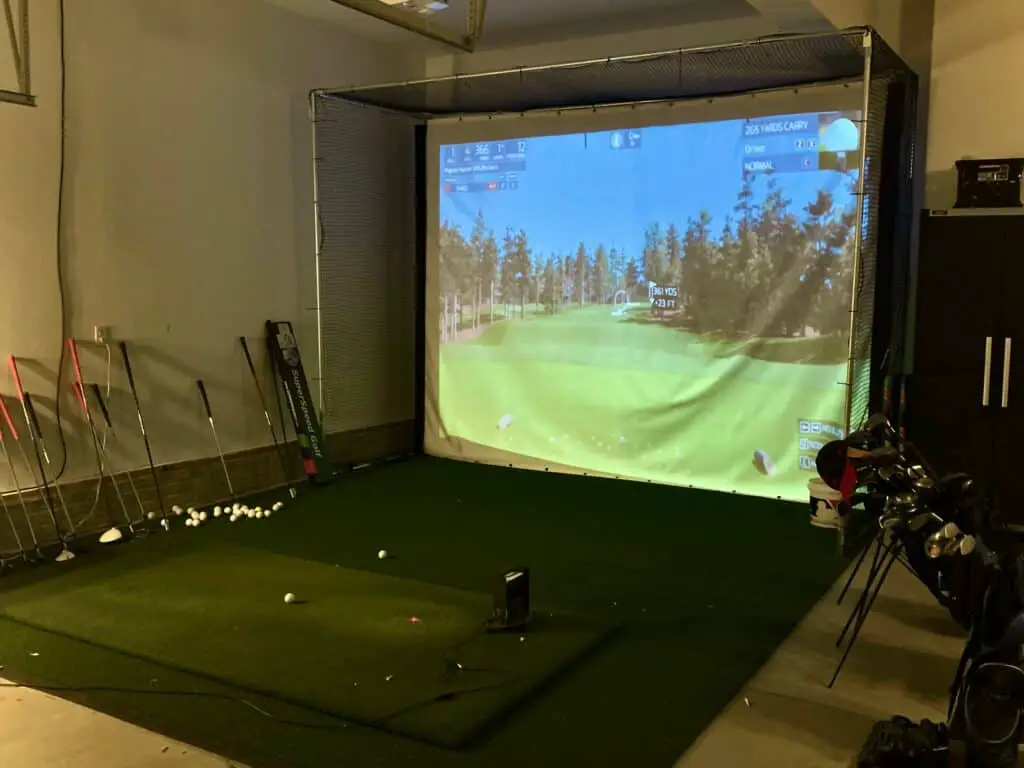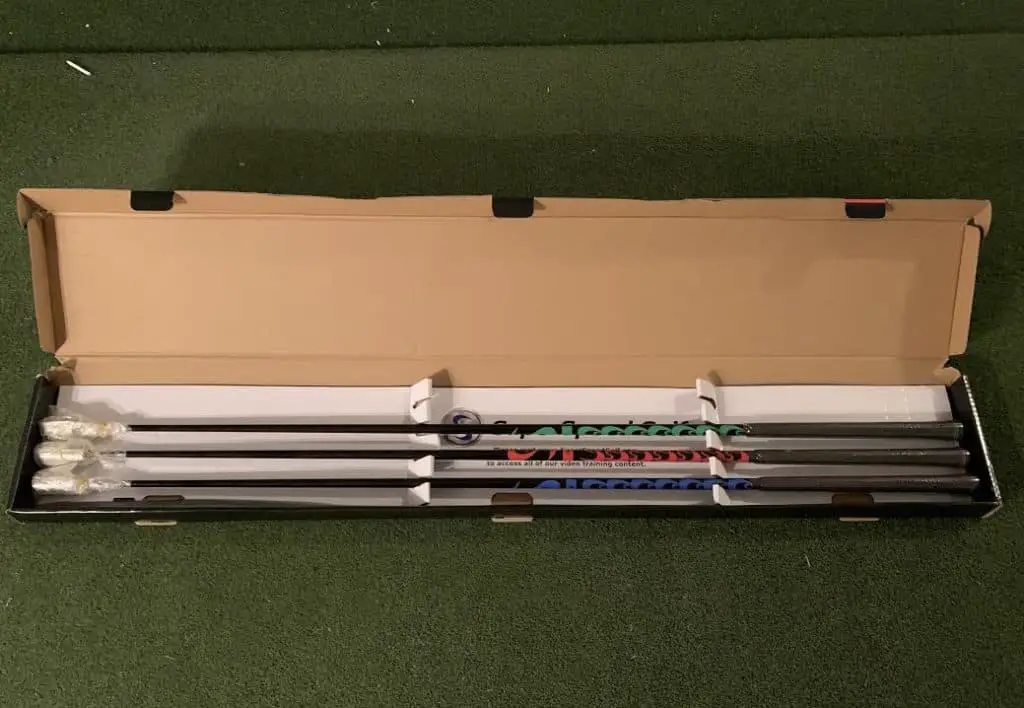The carry distance in golf is one of the most important numbers you can know with each club in the bag.
Whether you are standing on the tee box with a driver in hand wondering if you can carry the bunkers or standing on a 145 yard par 3, this number is essential.
Many golfers only have a vague idea on how far they carry each club and often will overestimate their true carry distance, leaving the golfer in poor positions on par 3s and approach shots on par 4s.
Golf is much easier when you have a better idea of your true carry distance. There are also some options on how to improve your carry distances to make the game easier and more fun.
Below, I will dive into following topics related to carry distance in golf:
- Why carry distance is important
- How to measure your carry distance in golf
- How to increase your carry distance in golf
- What to do if you are between clubs
- The impact spin rate has on carry distance

Carry Distance in Golf: Complete Overview
#1 Why Carry Distance Is Important
Having an accurate carry distance for each club in the bag will help you manage your golf game better. There is nothing worse than a well struck shot that flies the green or comes up short because you have the wrong distance or you don’t know how far you hit a well struck shot.
Let’s look at some scenarios
Scenario 1:
You are standing on the tee box on a 410 yard par 4. The hole has a slight dog leg to the right with a bunker that protects the hole against a golfer cutting the corner slight. The bunker is about a 230 yard carry. If you have precise data that you carry your driver 240 yards on average, you have to decide if you want to try to make a solid swing with the driver and reduce the length of the hole by cutting the corner, or if you should stay left of it. Having the right information will help you manage your round of golf and what the appropriate shot is.
Scenario 2:
You are playing a short par 3 that is only 145 yards in length. The green is surrounded by bunkers on the front and both sides. To carry the bunker you have to hit the ball 137 yards, but can’t hit it more than 155 or you will fly the green. You now have an 18 yard gap in wich you have to hit the ball. The pin is in the front at 142 yards. You know you hit your 8 iron 145 yards when struck solid. You decide to go with the 8 iron and if you hit a bit short you will still carry the 137 yard bunker. Once again, the right information, puts in the best situation to play the hole and select the right club.
In both situations if you do not have the right distance or have any idea how far you carry your driver of 8 iron, you might try to hit a shot that is not best for your overall score.
Two Options To Know the Distance on Course
I would highly recommend that every golfer utilize a GPS based watch or a rangefinder. Some golfers might use both as the GPS will give you the front, middle and back yardage on every approach shot, while the rangefinder can give you the exact distance to a pin or anything that you can successful laser.
Resource: Are rangefinders worth it?
Having this information, along with how far you hit each club is the combination of information you need to play your best. If you don’t have this vital information, you are pretty much guessing and hoping on the course. Manage your game better and you will have better scores.
Resource: Are golf GPS watches worth it?
Here are my top two product recommendations:
#2 How To Measure Your Carry Distance in Golf
There are two options. First, use a launch monitor to map out each club in the bag. Second, use the old fashion way of getting the ball you play with on the course and an open driving range where you can hit to specific distances and take an average.
Option 1: Use A Launch Monitor
I would highly recommend a launch monitor. These portable devices can be used at the driving range, golf course or set up in your home net or golf simulator. These devices are game changers not only on being able to map your bag and know your distances, but they also provide quality feedback after on every shot and provide the following information:
- Carry Distance
- Spin Rate
- Launch Angle
- Spin Axis
- Total Distance
- Ball Speed
This information will help you map your bag, decide on which clubs are best for your game, develop a stock shot and much more. I love using my SkyTrak 365 days a year in my golf simulator setup.
The process for mapping your bag can looking something like this:
- Hit 5 shots with each club in your bag.
- Log the carry distance and total distance for each shot.
- Eliminate any outlier numbers (poor hits or low spin rates).
- Take the average and create a map of your bag.
My mapping of my bag looks like this:
| Club | Carry Distance (100%) |
| 4 iron | 190 |
| 5 iron | 181 |
| 6 iron | 171 |
| 7 iron | 163 |
| 8 iron | 153 |
| 9 iron | 143 |
| P Club | 130 |
| PW Club | 118 |
| SW Club | 105 |
| LW Club | 90 |
If you visit any PGA Tour even you wil see plenty of golfers utilizing their launch monitors. Why most can’t afford a Trackman, there are some very affordable options in the 500-2000 dollar range. I own the SkyTrak and thing the world of it.
Here are the top 3 options to check out:
Option 2: Use a Driving Range or Open Field
If you can’t afford a launch monitor at this time, here is another option.
- Find an open driving range or open field
- Take 10 balls of the type of golf ball you play
- Pick a target and either walk it off or use a rangefinder.
- Hit 10 shots with each club in your bag and take an average.
- Your rangefinder can help you get a specific distance.
Go ahead and create a chart of each club and their carry distance like the one above.
Resource: SkyTrack Launch Monitor: The Ultimate Game Improvement Tool

#3 How To Increase Your Carry Distance in Golf
Golfers have several different options: hit the ball more on the center of the club face or add club head speed to your swing.
The option of increasing club head speed to your swing might be more realistic than you might think. With the SuperSpeed Training System you can use a training protocol every other day and it only takes 15 minutes per session. In these protocols you will swing three different weight swing sticks a specific number of times. The goal and the science is based on overspeed training and swinging a lighter club faster than you normally swing. You are training your mind and body to swing faster.
Did you know that your mind will only allow your body to swing as fast as it feels comfortable to be able to stop without injury? This is where the overspeed approach works. Swinging a club that is 20% lighter than your driver will train both your mind and body to move at faster speeds.
Golfers can expect to see a 5-8% increase in miles per hour as early as the first training session. This could mean an additional 20-30 yards with the driver. The results are real and I have experienced them myself. I have now added 7-10 miles per hour per average on my swing speed, resulting in 25-30 yards on average. I have been impressed and am thankful I was introduced to SuperSpeed Golf and the overspeed training protocols!
They are worth checking out. Check the price of SuperSpeed Golf, here!
Potential Results with SuperSpeed Golf Chart:
| Original Swing Speed | After 4-6 Weeks | New Carry Distance | Total Distance |
| 95 | 102 | 245 | 265 |
| 100 | 108 | 259 | 279 |
| 105 | 113 | 271 | 291 |
| 110 | 118 | 283 | 303 |

#4 What To Do If You Are Between Clubs
In my chart above for my clubs I hit my 9 iron 143 yards and my 8 iron 153 yards. If I come to a par 3 with a pin that is at 148 yards, this is right between my two clubs. Here are some factors to consider when this happens:
- Where is the most danger?
- Is it better to be long or short?
- Do I have to carry the ball a specific distance to fly a bunker?
- What is the wind doing?
- Is the shot uphill or downhill?
All of these factors play into my decision. I will more times than not take the bigger club and swing slightly less than full and try to work the ball in slightly from right to left. This is my go to shots when between clubs.
However, if the wind is too my back or if the hole is slightly downhill I might go with the 9 iron and give it a good strike.
Practicing these shots on a launch monitor can be helpful and you can expand your chart out and add a 90%, 80% and 70% carry distance for each club. This will give you plenty of options from each yardage. This complete chart is preferred by some golfers if they are analytical and want all of this information.
Personal Experience: This past season I found a lot of success with three different driver swings which includes: A standard stock shot (normal swing), a “bunt” swing (something less than normal speed), and a “blast” (max speed). While I hit the standard stock shot the majority of the time, the bunt swing comes in handy 2-3 times per round and the max swing is usually on a wide open par 5. Learn these three shots and watch your game go to another level!
Resource: How to increase ball speed in golf! (2 Keys)
#5 The Impact Spin Rate Has on Carry Distance
Have you ever had one of those flier lies in the rough from 155 yards and you hit your 7 iron or 8 iron 170 and flew the green? This is often a result of a lower spin rate. On average, if you take the number club that you hit and multiply it by 1000, this is the average spin rate for each club. So a 7 iron would spin at 7,000 RPMs and an 8 iron at 8,000 RPMs.
When the spin rate gets lower than that the ball will often fly further and it might be difficult to hold a green with mid irons if the spin rate is too low, but you will get extra distance.
The same rules apply for a driver. Most golfers would be best to live in the 1,800 to 2,800 RPM range with their driver. Anything above 3,000 and you will lose distance and anything below 1,800 might result in a knuckle shot that doesn’t carry far enough and you lose control.
Having a launch monitor to learn more about the impact on spin rate has helped me grow my knowledge and now when I see a shot when golfing, I can see the reaction in the air and know if the spin rate was too high or too low.
The most important part with the irons shots is the consistency of the carry distance vs getting the highest carry distance possible. You want the confidence that if you strike your 8 iron well that it will carry the distance you expect within 4-6 yards.
Resource: Why is spin rate important in golf? (complete overview)
Take Action – What You Can Do Today to Get Better
What does this mean for you? I believe in the following recipe to get better:
1 – Improve your motion in the golf swing by identifying a golf instructor. Here are some options:
Here is a list of golf instructors that we have reviewed:
2 – Train to swing faster and improve your swing speed. Here are some options:
Looking to gain more Speed and Distance in your swing. Two Options:
3 – Understand course strategy and work to break through your next barrier. Here is a series on breaking through:
We have provided guides on how to break 100, 90, 80 and 70. Check out more below, if interested.
4 – Practice Frequently
Did you know that I build a golf simulator in my garage and have played over 500 rounds of golf on my SkyTrak system? It has been a game changer and one worth checking out. Here are some of my other posts on golf simulators frequently asked questions:
- Is a Golf Simulator Worth It?
- How to Build a Golf Simulator?
- What is the Best Golf Simulator?
- Golf Simulator Accessories?
- How to Build a Golf Simulator for under $7000
- Top 11 Reasons to Buy a SkyTrak
- How to Build a Golf Simulator for Under $1000
- Why Build A Golf Simulator?
- What Space is Needed?
- Can A Golf Simulator Improve My Game?
- How Much Does A Golf Simulator Cost?
- Don’t Forget to Check out our 15 best golf swings of all time.
